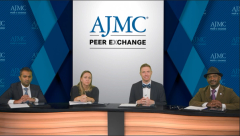
Product Preference with NCCN Category 1 Status
Dr Haumschild leads a discussion regarding frontline MM treatment products as categorized by NCCN.
Episodes in this series

Ryan Haumschild, PharmD, MS, MBA: NCCN [National Comprehensive Cancer Network] sometimes has recommendations, but have multiple recommendations, potentially as a category 1 or a category 2a. How do we prioritize products that have the same recommendation from NCCN? Dr Thertulien, how are products preferred with category 1 status from the NCCN differentiated in your clinical pathways? What factors are considered within multiple myeloma?
Raymond Thertulien, MD, PhD: That’s an excellent question. NCCN investigators review the data just as we do. We give a lot of value to the NCCN preferred regimens because they have a lot of high-quality data to back them up. If you look at the NCCN Guidelines, they also give you some cost. They tell you the regimens that are at lower cost but similar efficacy and safety. That helps a lot in adopting regimens that are on NCCN. We’ve adopted a lot of the regimens from NCCN, particularly the preferred regimens. The issue that we have in myeloma is when you get to the second, third, and fourth line. When you look at NCCN, any regimen you have that you didn’t use in the first line is put in the second line. When you go to the third line, for relapsed/refractory [myeloma], all these regimens in the second line are also there—they’re telling you that whatever you don’t use in the first or second line is fair game. Once you reach that line of therapy, there’s no preferred regimen. You’re going to have to make that decision based on the patient because you have to individualize the treatment. You look at the patient. You look at how frail or how fit the patient is, what comorbidities they have, and what adverse effects they’ve experienced from prior regimens. You choose a regimen that will benefit the patient, but you also try to maintain the quality of the life for the patient when you reach those lines of therapies. That’s the way we tend to prioritize our regimens.
Ryan Haumschild, PharmD, MS, MBA: Excellent. Dr Lipe, I’ve got a question for you. There are so many emerging clinical data coming out—new and improved therapies, new studies with different combinations. How are you evaluating all these? How are you integrating them into your EMR [electronic medical record] or your treatment pathways for your providers?
Brea Lipe, MD: We have a commercial pathway, so that’s how they do their commercial thing. Dr Thertulien has been very eloquent in explaining this. The way we incorporate these things isn’t a pathway-driven process. We review data, and we have a monthly myeloma meeting that all myeloma stakeholders are welcome to attend. Our providers, our pharmacists, anyone interested in myeloma, our research staff—they all come, and we review the most recent trial publications or abstracts. After ASH [American Society of Hematology Annual Meeting], we’ll meet and ask, “What did you like? What did you not like?” After the recent teclistamab approval, we had a meeting and asked, “How are we going to do this? How is this going to look? Does everybody understand the toxicities, the adverse effects, and how to do this?” We try to have monthly meetings, and we bring to the table what’s relevant at that time. All of us are in that area. It’s a great way to exchange ideas and have a robust conversation about what we like and what we don’t like. We’re not necessarily mandated to do it this way, but we discuss how things are going and incorporate that into our own practices.
Ryan Haumschild, PharmD, MS, MBA: That monthly meeting is a good cadence because as data and new approvals are coming, you have a chance to talk frequently. Dr Nadeem, with your internal pathways, how frequently are you all meeting and keeping everyone updated? What triggers an update?
Omar Nadeem, MD: We have scheduled meetings twice a year. Those are there to review the data in terms of the previous 6 months about on-pathway and off-pathway rates. That gives us time, usually after major conferences, to discuss some of the data or anything that comes up in terms of adding to our clinical pathways. We also have the option of having ad hoc meetings because sometimes we get these approvals in bunches in myeloma. It doesn’t follow that schedule. At that point, if we feel it’s important enough to have a breakthrough medication to offer patients well before our next scheduled meeting, then we set up a meeting to review that approval in real time. It’s flexible, but we typically meet 2 to 4 times a year to review the pathways.
Transcript edited for clarity.
Newsletter
Stay ahead of policy, cost, and value—subscribe to AJMC for expert insights at the intersection of clinical care and health economics.








































